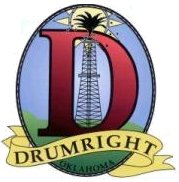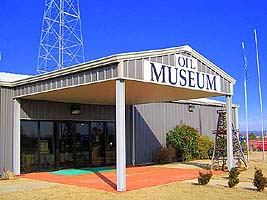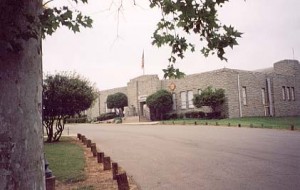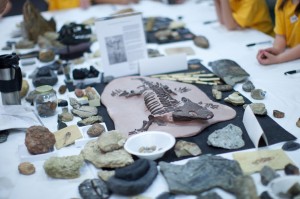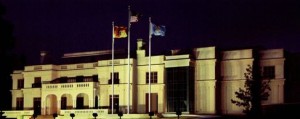Most Sooner State museums, especially the many Oklahoma petroleum-related museums, exhibit America’s exploration and production heritage, which began in Pennsylvania in August 27, 1859. These museums also teach visitors about the modern energy business.
Look for more educational resources in Texas Petroleum Museums and other state oil and gas museums.
Ames Astrobleme (Crater) Museum

The Ames Astrobleme Museum features all-weather video panels describing the impact crater’s geological significance.
About 450 million years ago, a meteor struck north-central Oklahoma, creating an impact crater more than eight miles wide. Today, the rural community of Ames proudly claims the crater as its own – and as an important contributor to the geological knowledge of the nation’s petroleum industry.
In 2007, Ames citizens opened one of the most unique of the Oklahoma oil and gas museums. Their astrobleme museum – describing the meteor’s (estimated to have been the size of a football) impact – and its relationship to a 1991 major oil discovery by independent oilman Harold Hamm. The museum, which requires no staff, features all-weather video panels on its north and south walls. The panels describe the crater’s formation…and its geological significance. The Ames crater impact site is among the largest producing craters.
Learn more in Ames Astrobleme Museum.
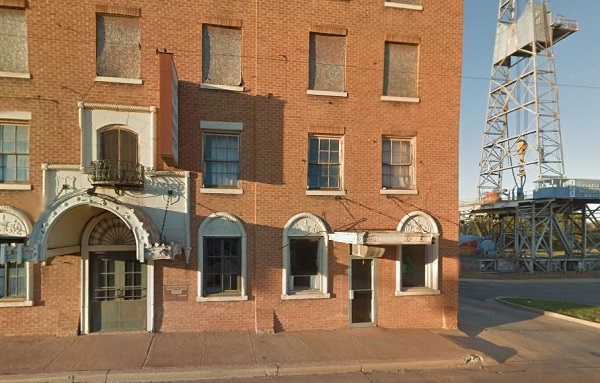
The donated Parker Drilling Rig No. 114 stands on display to welcome Route 66 travelers to Elk City. It is 180 feet high – one of the tallest in the world – and is next to Casa Grande Hotel, once home to the Anadarko Museum of Natural History.
Anadarko Basin Museum of Natural History
The today shuttered Anadarko Basin Museum of Natural History is located on Route 66 on Main Street in Elk City. Unfortunately, the museum, founded by oil history enthusiast John West and others, was closed because of a lack of funding. The museum building, the Casa Grande Hotel, remains listed on the National Register of Historic Places. A powerful tourist attraction stands beside the shuttered museum: Parker Drilling Co. Rig No. 114 — one of the world’s largest drilling rigs, 181 feet tall, and visible from Interstate 40.
Bartlesville Area History Museum
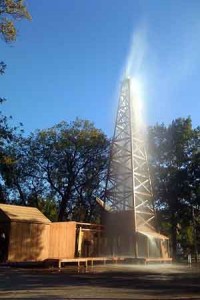
A gusher re-enactment of the dramatic moment that changed Oklahoma history highlighted the 2008 dedication of a new replica derrick at Discovery 1 Park in Bartlesville.
The Bartlesville Area History Museum, established in 1965, ensures the collection, preservation and exhibition of the rich and varied history of Bartlesville and the surrounding areas. The collection includes artifacts, historical objects, photographs, art illustrations and files that focus on the development of communities.
Thousands of photographs tell the story of Bartlesville — and the first glass bottle made in Oklahoma was produced by the Great Western Glass Factory; a piece of casing from the Nellie Johnstone No. 1 recalls the oil boom; and a cowboy hat worn by an attendee of the famous “Cow-theives and Outlaws Reunion at Woolaroc Ranch.”
The museum’s photographic collection which includes thousands of photographs from photographer, Frank Griggs, who came to the area in 1908, captured half a century of growth and development of the community through his camera lens.
Bartlesville’s Discovery 1 Park includes an 84-foot derrick — rebuilt and dedicated in 2008. The park’s first replica derrick was erected on the original site in 1948.
Cherokee Strip Regional Heritage Center

The Cherokee Strip Regional Heritage Center, opened in 2011 in partnership with the Oklahoma Historical Society, tells the stories of settling the Cherokee Strip – and includes petroleum history exhibits.
The Cherokee Strip Regional Heritage Center is an Oklahoma tells the extraordinary story of settling the Cherokee Strip from a state-of-the-art facility that opened April 1, 2011. Exhibits spotlight key industries that fostered the economic development of Northwest Oklahoma. The center, administered by the Oklahoma Historical Society, is fully accessible to all visitors.
Among the petroleum exhibits is a portable drilling rig – mounted on a Ford truck –of George Failing, a pioneer in oilfield technology. Touring the 6,000 square feet of exhibit space, visitors will discover many other educational exhibits. Read more in this article about the center’s opening.
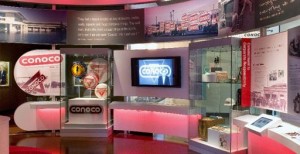
The Conoco Museum in Ponca City tells the story of a major oil company that began as a small kerosene distributor.
The Conoco Museum opened May 12, 2007, in Ponca City. It includes five areas exhibiting the evolution of the company’s business identity, marketing – and innovative onshore and offshore technologies.
One exhibit recreates a 1950s R&D laboratory; another depicts an outdoor scene of a “doodlebugger” at work; a third explains the technology behind the world’s first tension-leg offshore platform. These and other exhibits tell the story of a major oil company’s development from a small kerosene distributor serving 19th century pioneer America into a diversified global energy company.
During his years as a marketing executive with Texaco, (now part of Chevron), Jim Conard accumulated an extensive collection memorabilia from the company where he began working in 1963. He also had worked as a teenage at his father’s service station. In 2006, Conard, who today lives in Atlanta, donated his Texaco collection to his hometown museum in Miami, Oklahoma.
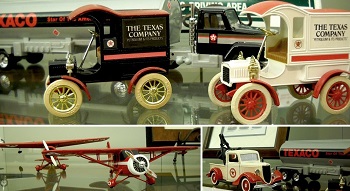 Today, Miami’s Dobson Museum collection is part of Route 66 exhibits that span decades of U.S. petroleum history. Texaco was always the iconic brand on Route 66, according to Conard. “Texaco had stations in all 50 states and advertised itself as ‘The Star of the American Road,” he noted in a Chevron Retirees Association publication in 2016.
Today, Miami’s Dobson Museum collection is part of Route 66 exhibits that span decades of U.S. petroleum history. Texaco was always the iconic brand on Route 66, according to Conard. “Texaco had stations in all 50 states and advertised itself as ‘The Star of the American Road,” he noted in a Chevron Retirees Association publication in 2016.
Conard, a former faculty member of Northeastern Oklahoma A&M College, in 2016 received the Award of Merit after a decade of service on the college’s Development Foundation Board of Trustees, raising money for student scholarships and campus programs.
The Dobson Museum, off historic Route 66 in Miami, includes a research center, an American Indian cultural collection, a Mickey Mantle tribute, displays about area mining, and an art and photography collection. Operated by the Ottowa County Historical Society, the museum is open to the public for free on Sunday, Wednesday, and Friday, 1 p.m. to 4 p.m.
Drumright Community Historical Museum
A March 1912 oil discovery on the Wheeler farm in Creek County started yet another Oklahoma oil boom. Thousands rushed into barren hill country to found a dozen towns. Drumright was in the heart of the oilfield.
Located near Cushing (about 50 miles west of Tulsa on highway 33), the Drumright Historical Museum is housed in a 1916 Santa Fe depot listed on the National Register of Historic Places. Five exhibit areas include the Oil Room and its large collection of memorabilia and tools used to drill the Drumright oilfield, which in 1919 produced three percent of the world’s oil.
Outside is a collection of large equipment – and a cannon on the front lawn was used to shoot the bottoms out of burning oil tanks, notes historical society member Pam Scott of Swinea Well Service, Inc. “The town has changed and the oil boom is no longer what it was, but the history remains” she notes. The museum is located at 122 East Broadway, not far from Drumright’s Boomtown Theater.

The Frank Phillips mansion was completed in 1909 — after the oilman’s drilling 81 straight successful wells.
In 1897, the frontier town of Bartlesville in Indian Territory became the site of the first commercial oil well in Oklahoma. Frank Phillips, an ambitious barber-turned-bond salesman from Iowa, visited Bartlesville in 1903 to assess business possibilities in the surrounding oilfields. He returned permanently two years later with his wife Jane and a young son. After a series of failures that nearly caused him to abandon the business, a string of 81 straight successful oil wells insured his place in petroleum history.
By 1909 the oilman had completed construction of his mansion. From then until his death in 1950, the home was the setting from which he — and the Bartlesville community that grew up around his company — played a key role in the development of the oil industry in America. Tour the 26 room Neo-Classical mansion (designed by architect Walton Everman) of the Phillips Petroleum Company founder at 1107 Cherokee Avenue.
Greater Southwest Historical Museum
The Ardmore Chamber of Commerce website includes the history of Ardmore, born with the establishment of the Santa Fe Railroad in 1887. The Greater Southwest Historical Museum preserves the history of south-central Oklahoma with exhibits from the mid-1800s to the present. They describe early settlements from Native Americans to the farmers, ranchers and townspeople who built communities in the region. Ardmore once hosted a Black Gold Festival celebrating the history and rich heritage of its oil industry.
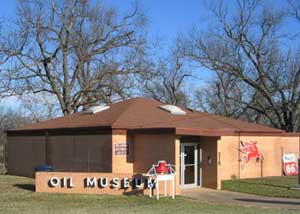
Discovered in 1913, the Healdton oilfield launched one of Oklahoma’s greatest oil booms. The Healdton Oil Museum tells the story of petroleum development in Carter County.
The opening of the Healdton oilfield in 1913 set in motion one of Oklahoma’s greatest oil booms. The shallow depth reduced the amount of capital necessary to drill a well. This gave the Healdton area a reputation for being a “poor man’s” field. The low cost of drilling in the Healdton field attracted a large number of Oklahoma investors.
Among those establishing a financial base through Healdton oil were Lloyd Noble, Wirt Franklin, Robert A. Hefner and former Governor Charles N. Haskell.
Also in the Healdton field, Erle Halliburton perfected his methods of oil well cementing, establishing his company as a leader in oilfield technology. The Healdton Oil Museum is located at 315 East Main Street.
Kerr Conference Center and Museum
Oklahoma oil and gas museums include the historic Robert S. Kerr Conference Center & Museum in Poteau was the home of the first native-born Governor of Oklahoma and long-time U.S. Senator, Robert S. Kerr. The Kerr family donated the mansion to Oklahoma in 1978. It has become a bed-and-breakfast inn.
Located next to the mansion is a museum depicting the history and development of Eastern Oklahoma. Kerr formed a drilling company — he would later persuade Dean McGee to leave Phillips Petroleum to become his partner.

The North Terrace of the Marland Mansion in Ponca City — where architect John Duncan Forsyth created a “Palace on the Prairie” in 1928.
Located on the grounds of the Marland Mansion, The Marland Oil Museum presents the saga of the amazing success of E. W. Marland’s early oil company in Ponca City. Visitors learn about the E.W. Marland family, the industry that made it all possible, and the petroleum boom town that rose from it all — Ponca City.
Marland was considered a maverick by many people in nthe industry. Others saw him as an innovative leader. He was among the first to believe in geology as a tool to help discover oil –and his methods proved to be effective. His geology department launched an innovative drilling experiment — core drilling — which became a major operation. Marland brought the seismograph from Germany and pioneered use of this geophysical method of locating favorable structures.
In 1927, Marland suggested that a statue should be erected to honor the spirit of the women who played such a significant role in the settling the region. This led to the Pioneer Woman Statue.
On April 22, 1930, more than 40,000 people gathered to witness the unveiling and hear famous Oklahoma humorist, Will Rogers. Marland presented the Pioneer Woman Statue and the land surrounding it to the State of Oklahoma and her people. The historic statue stands at Monument Circle, one block from the Marland Mansion.
National Route 66 & Transportation Museum
The National Route 66 & Transportation Museum in Elk City, “invites both children and adults to experience automobiles of the past with interactive and hands-on displays.
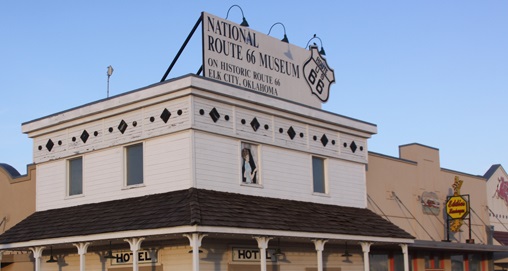
The National Route 66 Museum is in Elk City, Oklahoma.
“Drive” down Route 66 in a 1955 pink Cadillac and watch a black and white movie at a mock drive-in theater while sitting in a classic Chevy Impala.” The museum is part of the Old Town Museum Complex with artifacts from the lives of early settlers in Western Oklahoma on display at the Farm & Ranch Museum, and the Blacksmith Museum.
Nowata County Historical Museum
Twenty-four rooms trace Nowata County history, with artifacts ranging from the Civil War and Indian Territory Days to the Oil Boom, farming and cattle and much more.
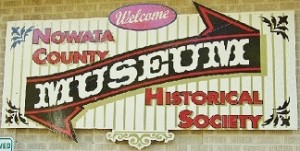
Located a few miles east of Bartlesville, the Nowata County Historical Museum includes petroleum exhibits.
The museum includes a period dentist office, jail cell and laundry. Indoor and outdoor exhibits. The Nowata County Historical Society also owns The Glass Mansion, home of a pioneer family.
“Thanks for the list of museums. I’ve been to quite a few, as I am sure most of your sites readers have. However, I can also add that I was born in one. The museum in Nowata, Oklahoma, used to be the community hospital, in which I was born in 1964. I often tell folks my birthplace is now a museum…”
Oklahoma Historical Society and Oklahoma History Center
The Oklahoma Historical Society was organized at the annual meeting of the Oklahoma Press Association, held at Kingfisher, on May 27, 1893. Its extensive website provides a detailed listing of museums throughout the state. “The rich cultural heritage of Oklahoma offers many opportunities to experience history up close and personal. From the prehistoric mounds at Spiro to the Route 66 Museum there are a multitude of sites to educate and entertain.”
Located on 18 acres across from the capital building, the Oklahoma History Center is a beautifully designed, self-guided exploration of Oklahoma – past to present. Within its 215,000 square-foot learning center are five state-of-the-art galleries housing more than 200 hands-on audio, video and computer activities.
The museum, a division of the Oklahoma Historical Society, collects, preserves and interprets the history of Oklahoma.

A decade in the making, the Oklahoma History Center is an 18-acre, 215,000 square-foot learning center.
Outside the center, the Devon Oil and Gas Exploration Park interprets some of the technology that is part of the fascinating history of Oklahoma’s oil industry.
Equipment found in the park explores the drilling, production and transportation phases of the industry. Much of the equipment was donated to the Oklahoma Historical Society in the mid-1960s. The technological innovations in Oklahoma oilfields helped revolutionize petroleum production worldwide.
Oklahoma Oil Museum (permanently closed)
Operated by the Seminole Historical Society, the Oklahoma Oil Museum, closed in order to focus on other Seminole area educational projects. The museum had provided an oil history educational experience about the Seminole Oil Boom.
Administered by the Oklahoma Historical Society, the Oklahoma Route 66 Museum in Clinton offers, “the ultimate Route 66 experience, visit the Oklahoma Route 66 Museum in Clinton. The museum offers visitors a personal journey through the history of the nation’s most revered highway. Encounter the iconic ideas, images, and myths of the Mother Road. “
Phillips Petroleum Company Museum
The Phillips Petroleum Company Museum opened May 12, 2007, in Bartlesville. Exhibits are displayed in seven major areas:
- A Pioneering Attitude – showing how the company became an industry leader, transforming basic oil and gas resources into a large number of useful products.
- Growing Strong – about the evolution of the Phillips and how the company survived a series of corporate battles.
- The One Big Family exhibit describes how Phillips became known for promoting the well-being of its employees.
- Bucking the Odds – what was it like in the rough and rowdy days of the Burbank Field?\
- Energy Provider – from refined petroleum fuels to super-cooled natural gas, creating ways to deliver energy to consumers. Taking to the Skies and Selling 66 – The Phillips Company actually produced its aviation fuels before its automotive fuels.
Sam Noble Oklahoma Museum of Natural History
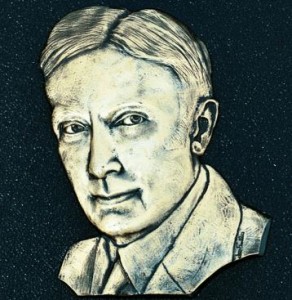
Oilman Tom Slick is among those honored at the Oil Pioneers of Oklahoma Plaza — an outdoor educational exhibit area at the Sam Noble Museum.
“In 1899, the Territorial Legislature of the future state of Oklahoma mandated the founding of a natural history museum on the campus of the University of the Territory of Oklahoma in Norman, now the University of Oklahoma. “Since that time, the existing museum has acquired over 5,000,000 objects. The museum conducts scientific investigations to preserve and develop a greater understanding and appreciation of natural resources and human cultural heritage.”
The museum today includes the Robert S. Kerr 3,248-square-foot auditorium. The Oil Pioneers of Oklahoma Plaza — a special outdoor educational exhibit area at the museum — opened in 2000. “The history of the state of Oklahoma is inextricably linked with the remarkable history of the oil industry,” noted then Conoco Chairman Archie W. Dunham. “The individuals identified here are true Oklahoma oil pioneers in that their endeavors were most significant in the development of the oil and gas industry in this very young state.”
Tom Slick, Oklahoma’s “King of the Wildcatters” is among those honored in the plaza. Slick, a self-taught geologist, discovered the giant Cushing oilfield in 1912.
Sarkeys Energy Center, University of Oklahoma
“The most comprehensive center of knowledge in the petroleum industry.” The University of Oklahoma Sarkeys Energy Center, completed in 1991, encompasses interdisciplinary institutes, including Mewbourne College of Earth and Energy. The institutes develop technology and programs that advance the energy industry and provide significant, “real world” research and education opportunities for students.
The center is also home to the Lawrence S. Youngblood Energy Library, which houses the combined geology and geophysics collections of the Oklahoma Geological Survey and the University of Oklahoma that began in the late 1890s, and today contains more than 90,000 catalogued volumes and more than 200,000 maps.
Stephens County Historical Museum
The Stephens County Historical Museumfeatures history lessons in the form of vignettes showcasing life in an early day town. A one-room schoolhouse, offices of a pioneer doctor, dentist and lawyer and a church. Petroleum-related related displays and county history includie oil field service industry giant Halliburton Energy Services. The company’s history begins with founder Erle P. Halliburton, who, after borrowing a wagon, a team of mules and a pump, he built a wooden mixing box and started an oil well cementing business in Duncan.
Oil industry and area history of the “Triangle Region,” bordered by the old Pawnee reservation and the Arkansas River and Cimarron River. In Pawnee County, the museum is 1/2 mile west of Cleveland on Hwy. 64, near the Arkansas River. The town represents one of many oil boom towns of the early 1900s.
The Tulsa Geoscience Center, orginally located at the headquarters of the Society of Exploration Geophysicists, today is a project of Energy America Educational Institute, Inc., an Oklahoma corporation with 501-c-3 tax status. There is one full-time Director/Teacher assisted by volunteers, many of are retired geoscientists, along with college and high school interns. The center offers “free, enjoyable and unique geoscience educational experiences to school children. These are educational experiences that no area school has the facilities to host and very few area teachers have the expertise to present.”
The center presently occupies over 5,000 Square feet with rooms devoted to a hands-on geoscience activity such as rock and mineral identification, fossil identification and earthquakes. Each activity lasts from 20 to 40 minutes – and school groups have traveled as far as 150 miles for the center’s educational tours.
Established in 1963, the Tulsa Historical Society holds an extensive collection of resources on the city’s rich past. The collection contains nearly 5,000 still photographs, books, maps, documents, graphics, historical costumes and architectural remnants, and fine and decorative arts. The Tulsa Historical Society’s website shares photographs in the society’s collections – and there are thousands to browse!
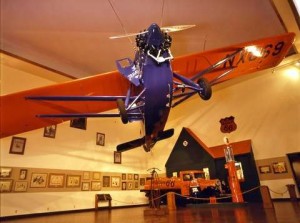
The museum at Frank Phillips’ Woolaroc ranch near Bartlesville, Oklahoma, added an Airplane Room in 1985 – a new home for the newly restored aircraft that won the 1927 Dole Air Race across the Pacific.
“Hidden away in the rugged Osage Hills of Northeastern Oklahoma, Woolaroc was established in 1925 as the ranch retreat of oilman Frank Phillips.” An oil patch exhibit opened in 1996 but is now closed to the public. It houses an authentic working powerhouse that supplied power to working equipment on the lease. A restored, working cable tool drilling rig is also preserved. Woolaroc is operated by The Frank Phillips Foundation, Inc., a nonprofit organization, whose mission is to preserve the rich heritage of Woolaroc as an educational and historical attraction.
_________________________________________________
The American Oil & Gas Historical Society preserves U.S. petroleum history. Become an AOGHS annual supporting member and help maintain this energy education website and expand historical research. For more information, contact bawells@aoghs.org. Copyright © 2022 Bruce A. Wells. All rights reserved.



